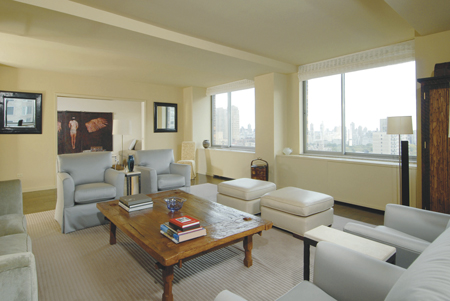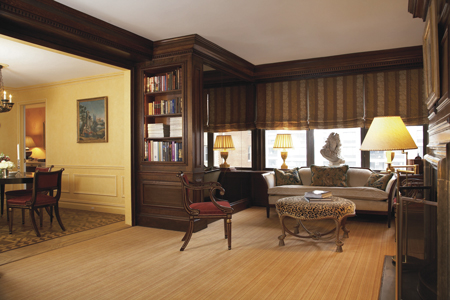THE STATE OF THE NEW YORK CITY RESIDENTIAL REAL ESTATE MARKET
AN
INSIDER’S VIEW OF THE LATEST TRENDS IN LUXURY RESIDENTIAL REAL ESTATE
BY
ELIZABETH STRIBLING,
PRESIDENT, STRIBLING & ASSOCIATES
Fall
has brought a brisk upbeat to the New York residential real estate market.
After a long and essentially quiet summer the pace of sales began to
slowly build up steam in October and now, in early winter, has gained
noticeable momentum.
Despite
dire media predictions, the dreaded real estate bubble simply has not
burst on our local scene. The question is whether it ever even existed.
Today, a gradual but steady renewed sense of confidence in purchasing
property has returned to the city.
Apartments
that had lingered on the market for over six months or longer are suddenly
beginning to sell. Equally, many brand new offerings are going
to contract in less than a month if initially priced correctly for today's
astute buyers.
Meanwhile, the overall inventory of available residential listings is
shrinking slightly. According to a recent survey by the appraisal firm
Miller Samuel, the number of co-ops, condos and townhouses on the market
in Manhattan decreased 3.6 percent over the summer months.
Does
this mean that the real estate market is actually improving? If so,
what accounts for recent bold headlines proclaiming that the New York
residential market is plunging? Where is the disconnect?
Certainly,
there has been a real estate downturn in heavily speculative markets
such as Nevada, Arizona and southern Florida. However, what do the latest
local statistics actually tell us about the state of the market in New
York City?

A
Very Active Market by Historical Standards
Indeed,
the third quarter statistics did show a drop in the average price of
a unit over the previous quarter. Various reports showed this decline
to vary from 7 to 10 percent. What the media failed to herald was the
fact that the average price of a unit had actually increased over a
year ago.
The
Miller Samuel appraisal report placed the average sale price at $1.3
million at the end of the third quarter of 2006, down 7 percent from
the previous quarter, but up 12 percent over the $1.15 million average
sale of a year ago. If anything, the recent slowing of the rise of prices
is a natural evolution of a more balanced market.
The
press has overdramatized an inevitable drop in prices by portraying
it as a catastrophe. In fact, the New York City housing market is adjusting
in an orderly process. The boom years of 2004 and 2005 were accelerating
at such a rapid pace that continued growth could not be sustained. If
the overall national housing market is now slowing, on average it has
simply returned to the activity level of 2003 which was a very good
year. This is a cyclical rebalancing rather than a crash.
Interest Rates Remain Quite Low
Most
importantly, mortgage money remains affordable. By historical standards,
mortgage rates remain low and should provide a cushion against a dramatic
downturn in the real estate market. Do not forget that the bleak real
estate market of the late 1970's was fueled not only by an oversupply
of inventory but equally by mortgage rates of 16 to 18 percent for a
fixed rate loan.
Today,
the combination of slightly lower prices and affordable mortgage rates
should lead to a natural self correction of the housing market, and serve to re-stimulate
the buying process. Even the gloomy forecasts of a rash of foreclosures
due to the recent popularity of adjustable rate mortgages has not occurred.
As
monthly payments on these loans have begun to balloon upwards in recent
months, many borrowers are simply refinancing with new adjustable rate
mortgages that keep monthly payments low. These borrowers believe that
by the time their current mortgage rate goes up either their income
will have increased or they will have moved and thus sold, or simply
refinanced the loan again.
This
philosophy has resulted in a recent surge in mortgage refinancing, and
has assuaged fears that rising interest rates would produce either foreclosures
or a cut in consumer spending. Naturally, such refinancing is based
on the belief that housing prices will continue to rise in the future,
but in the meantime has served to bolster the current market, or at
least put off the day of reckoning.

New York City's Economy Remains Strong
Today,
New York City is flourishing with a strong local economy, low unemployment,
and a record year for Wall Street, where year end bonuses have increased
very substantially over last year. Dismal predictions by the media for
the local housing market have simply ignored these positive factors.
The
current uptick in the residential marketplace may be a valid knee jerk
reaction to these more promising signs of the times. Armed with still
affordable mortgage money, and aware that prices have decreased slightly,
buyers are back in the New York City residential marketplace after a
long summer break.
Sales Prices Have Stabilized
Clearly,
this renewed activity is a result of a more balanced market. Gone are
the frenzied days of 2004-2005 when a buyer had to offer the full asking
price the first hour an apartment was listed, all the while praying
that his bid would not be topped. Today, the average number of days
that an apartment is on the market has stabilized at approximately 150.
Buyers
have time to reflect and comparison shop before committing to a thoroughly
thought out choice. Sellers have realized that property must be realistically
priced to sell, and, even then, sellers must be willing to negotiate
nominally. During the height of the market in 2004, property either
sold at above asking prices or at only 1 percent below the ask. Today,
there is a negotiability factor somewhere between 3.5 and 5 percent
on average. This is a far cry from the all too standard negotiability
of 15 to 20 percent in the early 1990's.
Today's
modest percentage of negotiability clearly reflects a stable market.
That said, there is an increasing demand and desire for blue chip property.
Whereas all property moved at a fast clip in the boom years of 2004
and 2005, today's buyers are much more selective and finicky.
Location
counts. Condition is valued more than ever; lengthy and costly renovation
is avoided at all costs. The price of an apartment overhaul has skyrocketed
and boards have become more onerous in allowing major construction or
combinations. Views and light are coveted more than ever. With more
time to make a decision, buyers have become more choosy.
Just
as the word negotiation has re-entered a seller's vocabulary, developers
of new up-to-the-minute light filled condominiums have also realized
that they must consider some concessions for certain units within their
offerings.
In
some instances, a portion of the closing costs have been assumed by
a developer to jumpstart sales. Other developers have lowered asking
prices on lower floors to encourage initial sales while raising prices
on higher more generally desirable floors.
Some
developers may give a slight discount to a buyer who buys several units
within a new offering to offset their future personal construction costs.
However, just as some sellers refuse to budge on prices, many developers
hold firm. Although the principle of negotiation has come back to the
overall real estate marketplace, it is certainly not the prime factor
in successfully concluding a deal as was often the case in former less
healthy markets.

A Soaring Rental Market
The
big news of the current New York residential world is the roaring strength
of the rental market. The city's economy is strong and its unemployment
rate, at under 5 percent, is at its lowest point since 1988. As mortgage
interest rates rise, some potential buyers are choosing to rent rather
than purchase.
Today,
the demand for rental property has reached a crescendo. As a result,
the vacancy rate for rental apartments has dropped below 0.5 percent,
and rents are rising in a tight new rental market. The monthly threshold
for a decent one-bedroom apartment has escalated from $2,500 to a hefty
$3,000 on average throughout the city.
Landlords
are even beginning to turn existing long owned properties into new luxury
rental buildings or in some instances may even consider converting an
already in the pipeline condominium development into a rental building.
After many years of a stagnant rental market, the rental arena has once
again revved up in the landlord's favor.
Strong Super Luxury Sales Pace
The
super luxury sales market is also noticeably strong. The upper echelons
of this rarified world are experiencing record prices. The top tier
luxury benchmark price of $10 million has increasingly been replaced
with sales in the even higher ultra-luxury category of over $20 million.
According
to recently released public data of cooperative sales transaction records,
resulting from a new state law enacted in July, there have been nine
cooperative apartments that have sold in excess of $20 million so far
in 2006 with several more pending. In addition, there has been a record
breaking house sale of a whopping $53 million in October 2006 for the
legendary 20,000 square foot Harkness House at 4 East 75th Street. With
sales of this magnitude, it is clear that New York City continues to
be the trophy address for the rich and famous.

Many Manhattan Neighborhoods See Surge of New Construction
New
York has always been a unique place like no other. Its drawing power
alone continues to sustain its real estate in good and bad markets.
From
far uptown to the tip of downtown, neighborhoods throughout the city
continue to be transformed. Harlem, Chinatown, Wall Street, Hell's Kitchen and the
far west side of Chelsea are all experiencing a burst of new energy.
In fact, Harlem is on a boom ride. The revitalization that began ten
years ago with the sale of architecturally important brownstones has
erupted today into a wealth of new residential and commercial construction.
Gone
are the brownstone bargains of yesteryear. New condo construction is
underway all over Harlem. Condos on Central Park North command as much
as $1,200 a square foot. Market rate rentals are being constructed on
both the east and west sides of Harlem. The megastore Target has just
signed a lease for 135,000 square feet at East River Plaza, a new shopping
center on a six acre site adjacent to the FDR between 116th and 119th
Streets. Commercial space in the center of Harlem is fetching rents
close to $150 a square foot. Harlem has never been hotter.
Meanwhile,
a neighborhood as seemingly contained as Chinatown is suddenly experiencing
a transformation into a much more diversified area. Close to Soho and
the Lower East Side, Chinatown has become an alternative address of
choice for many non-Chinese New Yorkers. Within the last two years,
five high end condominium buildings have opened in Chinatown, and upwards
of eight more are presently being built or on the drawing boards.
Offering
a variety of amenities, these various offerings often cost as much as
$1,000 a square foot, a figure which has rapidly become the average
for the city. Equally appealing to the affluent Chinese community, these
new luxury condominiums often feature well ventilated kitchens with
top-of-the-line stove exhaust hoods to accommodate the special needs
of Chinese cooking.
Designated
zoning in the area will protect the low lying scale of the neighborhood,
but new luxury condos are rapidly springing up that contrast sharply
with Chinatown tenements of an earlier era.

Another
changing neighborhood is Wall Street, which today has more residential
condominium developments than investment banks.
During
the past 10 years, lower Manhattan has dramatically transformed itself
from a business community into a 24/7 residential and mixed use district.
Upscale
luxury retail shops such as Hermes and Tiffany as well as trendy gourmet
restaurants have moved into the area. In fact, lower Manhattan is the
fastest growing residential community in the city; from just 22,000
residents in 2001, there will be a projected residential population
of 42,000 in 2007.
Downtown
has also become a global tourist destination. At present, there are
2,500 hotel rooms located downtown with an occupancy rate of over 89
percent; many new hotels are currently planned to meet the increased
desire of visitors to stay in this area. Let us just hope that the rebuilding
at Ground Zero can move forward in a timely fashion to bring acceptable
closure as well as renewed hope to our city.
Branding of New Developments
As
residential buyers broaden their geographic parameters to consider all
neighborhoods of the city, developers of new condominiums are placing
increased emphasis on branding to create a special buzz for each new
luxury offering. This is noticeable all over Gotham. In some instances
it is an evocation of the quality craftsmanship of the past.
At
The Parkwood, developer Henry Justin and designer Alan Tanksley emphasize
the classic detailing and artisanal attention of a prewar bygone era
in contemporary half floor lofts located at 31 East 28th Street, just
steps from Madison Square Park. Equally, it could be cutting edge up-to-the-minute
modern detail that lends distinction to a new building.
At
Loft 25 in Chelsea at 420 West 25th Street, RAL offers unique all glass
tempered kitchens manufactured in Italy by Schiffini that have never
been seen before in New York City. Creating another distinctive twist,
Gramercy Property Group has transformed a 1905 carriage house at 406
West 45th Street in Clinton into sleek new apartments, while retaining
the original exposed brick walls and timber beams reminiscent of the
gaslight age.

The
ultimate concept of branding may be found at The Hit Factory at 421
West 54th Street which is presently being converted into condominium
lofts by HF Sponsor Corporation.
The
legendary Hit Factory was a mythic recording studio, where scores of
platinum and gold records were recorded by such luminary artists as
John Lennon, Billy Joel, The Rolling Stones, Madonna and Bruce Springsteen.
Displaying multiple platinum and gold albums that were actually recorded
on the premises in the new condo lobby, The Hit Factory Condominium
will spin a new modern residential identity to the vibes of its rock
roots. How groovy is that? In the growing and increasingly competitive
world of current condominium development, distinctive branding is essential.
As geographic boundaries blur, buyers respond more and more to the special
atmosphere that best suits their own personal lifestyles.
Market Balanced Between Buyers and Sellers
With
a healthy choice of new development and resale property all over New
York, and slightly more bargaining power, today's residential buyers
are more in the driving seat than they have been in recent years. However,
many potential sellers maintain a wait and see attitude.
Without
the motivating factors of a job change to a new town or a personal family
crisis, many sellers simply are not listing their property until they
perceive that the residential market is on a strong rise again. All
said, we seem to have reached a back to normal market with a fairly
evenly balanced tension between buyers and sellers. Perhaps this is
what is described as a soft landing.
The
Right Broker Makes All The Difference
Stribling.com

© 2015 TLC Magazine Online, Inc. |